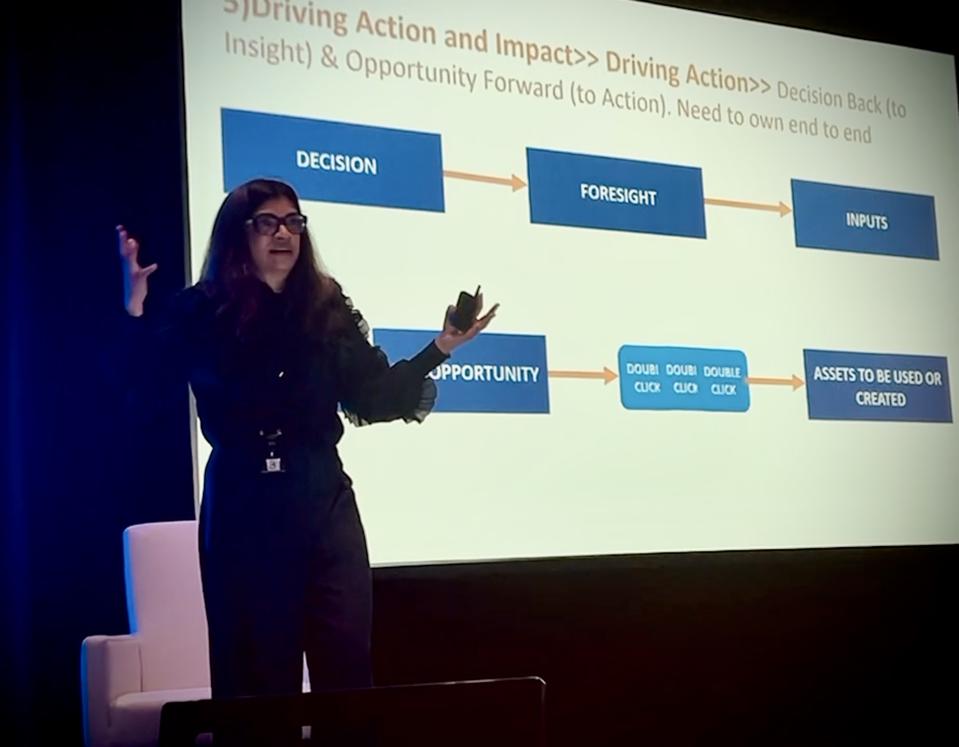4 Lessons From Scaling Foresight-Driven Decisions At The Estée Lauder Companies

The word foresight has a mystical sound akin to fortune telling. Yet, the business reality of this growing discipline is much more practical, according to The Estée Lauder Companies’ Kalindi Mehta, Vice President of Consumer Foresight and Predictive Analytics, Enterprise Marketing & Data.
“From a business and organizational perspective, foresight is about applying a future-forward lens to business decision-making,” she said in a recent Decision-Back Podcast.

That simple statement explains why 80 percent of decision-makers ignore data-driven insights. Data-driven analyses and insights are about what happened in the past. Unfortunately, this inherently backward-looking perspective often misses the mark since decision-making is about what will happen in the future. Foresight addresses this mismatch by combining analytical machinery with human empathy to directly address decision-makers’ future-facing needs.
Think Decision-Back To Go Beyond Data and Insights
“Insight is almost an irrelevant term in today's world, which is so fast changing,” said Mehta. “Analytics and insights should not just explain the past but tell you what the business needs to do tomorrow, creating consumer foresight that leads to action.”
This perspective is critical for data, insights and analytics professionals and the future-facing innovation, research & development and marketing teams they support. Business decision-makers live in the future, especially in rapidly changing markets. It is no longer enough to understand what happened before and make forecasts assuming that numbers from the past can reliably predict future results.
According to Ms. Mehta, “You have to think decision-back to make consumer foresight work. So start with the decision that's going to be made and then work backward so what you're working on has a clear business action that will come from it.”
At The Estée Lauder Companies, foresight involves understanding a wide range of business issues, market signals and trends that impact culture and consumers and applying that understanding to develop specific recommendations and actions. Foresight also involves exploring beyond your categories to look for disruptive trends and innovations in other industries that might steal market share or open new opportunities for business growth.
“Foresight links empathy to data,” Mehta emphasized. “It links math to meaning to give an organization a clear direction on what needs to be done tomorrow. It’s that spark of imagination on what could be.”
For example, early in the pandemic, her consumer foresight organization looked deeply into cultural trends to understand what the post-Covid world would be like. They realized that “healthification” was a cultural area likely to spike as the world transitioned to a new normal. Then, they applied foresight principles to explore the implications of the increased importance of health across the company’s many categories like make-up, hair, fragrance and skincare, including how people would express themselves and the looks, scents and ingredients they would seek.
Mehta explained, “That's why you can't just go by data. The more rigor you put into building foresight by linking data to meaning to wider culture influences, the more depth you bring to your foresight, the more likely you are to head in the right direction.”
Use Consumer Foresight To Balance Rapid Change And Long-Term Growth
Ms. Mehta built her consumer foresight expertise while working in the Asia Pacific region for many years before moving to New York and tackling Western markets. “Emerging markets always had a foresight mindset, even before the term foresight became popular, because things were evolving so fast and markets were always uncertain. In order to grow, you had to think future-forward.”
When she moved to North America, the changes wrought by digital technology brought a similar level of change to Western markets while also shrinking the world and bringing global markets closer together. Technology brought new ways to interact with consumers, sell products, and do research. This real-time evaluation and planning is now standard practice and leads to exciting results. However, it can also lead to a focus on short-term metrics at the expense of long-term growth.
“Because we get digital results so quickly, marketers become addicted,” she elaborated. “We see immediate feedback in terms of clicks or short-term sales, so if you're a marketer who's nervous about spending your money, and you're seeing that it's working right now, you tend to keep your focus there.”
The Estée Lauder Companies use a foresight-driven approach to impact areas like media decisions and new product launches to ensure that brands look at both short-term and long-term returns on investments. The goal is to create an ambidextrous organization that excels at exploiting short-term business opportunities while simultaneously exploring and developing long-term growth paths.
“Short-term is absolutely important. We’ve got to drive sales. We have the data. And the speed is incredible,” Ms. Mehta said. “But without consumer foresight, we'll get caught in a vicious circle of over-investing in short-term growth versus building business models, services and brands that are going to grow cumulatively over time without constantly increasing our investment.”
Four Steps To Foresight
While the promise of foresight is compelling, Ms. Mehta has found that it is easier to create foresight than to activate the capability across an organization. Based on the lessons learned during her experiences, she recommends four strategies for scaling foresight success:
1) Work Decision-Back and Opportunity-Forward: The data, analytics and insights organization must champion consumer foresight practices but with an explicit goal of moving beyond data and insights to drive business actions within the company. Do this two ways. First, work decision-back by identifying the business's key decisions and organizing foresight activities directly supporting those decision endpoints. Second, work opportunity-forward to make every insight project a foresight project, going beyond what business decision-makers ask to identify novel, concrete opportunities.
“You must take end-to-end responsibility for creating foresight and driving action, because if you don't do both, no action will happen, you won’t get ROI, and you won’t get more investment to drive future work.”
2) Embrace The Now: Lean into short-term thinking and reframe foresight around acting on today’s problems. Identify areas where foresight will bring immediate solutions to problems that stakeholders face. For example, The Estée Lauder Companies use consumer foresight to look at what’s going on in the culture of TikTok and Instagram so the company can go beyond simply following trends to actively creating their own trends week-to-week to keep brands relevant.
“There’s a lot of incentive to think short-term, so reframe foresight into three buckets. How do you react now? How do you anticipate the future? And how do you create and disrupt the future?”
3) Show The Results: Like any new business initiative, it’s critical to build a clear process for measuring the ROI of foresight. Since foresight efforts are always tied to business decisions, start by showing the actions the business took, then show the early results of those actions, then show the benefits your brands are gaining from those actions. Eventually, start showing financial results from those actions as they become more apparent.
“Show results early without waiting for perfect financial ROI. As soon as possible, start sharing the actions coming out of foresight with all levels of management to build belief in foresight.”
4) Infuse The Organization: While foresight starts with data and insights teams, ultimately, a single group cannot own foresight. The organization has to own foresight. Activating foresight as a capability requires organizational commitments and goals right from the top. Start with small successes to tell the larger foresight story. Then use foresight to paint a picture of the future that can unite everyone in the organization and even position the entire company for growth.
“Tech companies like Apple live and breathe by future-focused goals, and more CPG [consumer packaged goods] companies are following suit. Showing what's going on in the future helps keep the stock price up and keeps the optimism in the company going in the long run.”
Consumer Foresight Brings Clarity
Since decisions are about the future actions a company will take, consumer foresight is becoming a driving force of decision-making in leading companies. By combining data-driven machinery with human empathy and imagination, foresight promises to solve today’s problems and reveal tomorrow’s opportunities to help brands, categories, and entire industries remain relevant.
“Foresight doesn't bring certainty, but it brings clarity,” concluded Ms. Mehta. “It doesn't guarantee things. It lays out all the opportunities so that the business is clear on the bases for and risks of the decisions we make.”
This article was originally published in Forbes.
